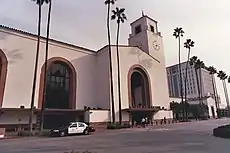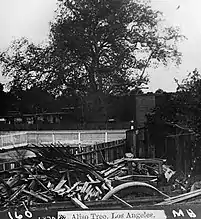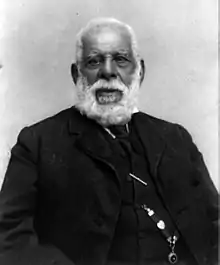Yaanga
Yaanga (alternative spelling: Yangna or iyáangẚ, written as "Yang-Na" in Spanish)[2][3] was a large Tongva (or Kizh) village originally located near what is now referred to as downtown Los Angeles, just west of the Los Angeles River and beneath the 101 Freeway. It is unclear what the village's population was prior to colonization, although it has been described as the largest village in the region.[4][5] People from the village were recorded as Yabit in missionary records[6] although were known as Yaangavit, Yavitam, or Yavitem among the people.[7][8] The original village seems to have only remained intact until about 1813. After being forcibly relocated several times, eventually eastward across the Los Angeles River, it was razed to the ground by the Los Angeles City Council under American occupation in 1847.[7][8][9]

Yaangavit were used as slave laborers[10] by Franciscan padres to construct and work at San Gabriel Mission and Nuestra Señora Reina de los Ángeles Asistencia and forced laborers for the Spanish, Mexican, and American settlers to construct and expand Los Angeles. After the founding of Pueblo de los Ángeles in 1781, Yaanga increasingly "began to look more like a refugee camp than a traditional community." The colonizers' dependency on Yaanga for forced labor is thought to be a reason for its ability to survive longer than most Indigenous villages in the region.[11][12] Buried intact deposits from Yaanga have been found throughout downtown Los Angeles, such as in the vicinity of Alameda Street, Bella Union Hotel, Union Station, Plaza Church, and the Metropolitan Water District Headquarters.[5]
Location

The original exact site of Yaanga is unclear because the village was evicted, forcibly relocated, destroyed and is now covered by downtown Los Angeles. However, it is known to have existed near downtown Los Angeles, just west of the Los Angeles River, and beneath the 101 Freeway.[4] An article written by several researchers located the original village site of Yaanga "about 1.4 miles southwest of the current N. Broadway Street at the Los Angeles River [and] in the neighborhood of Los Angeles Street between the current Plaza south towards Temple Street... [which] would have placed the village in close proximity to the pueblo’s earliest plaza and church. The [Los Angeles] pueblo was established immediately adjacent to Yaanga in 1781 in the area north of the current Los Angeles Plaza Church."[9]
Some historians position Yaanga as located slightly south of Los Angeles Plaza (Los Angeles Plaza Park), near or underneath where the Bella Union Hotel was located (now Fletcher Bowron Square). One historian concludes that "it is highly unlikely that Yaanga would have been located east of the present course of Alameda Street (i.e. beneath Union Station) because these areas would have periodically scoured during flood stages of the Los Angeles River, and higher, drier ground could be found farther west."[13]
Excavations
In 1962, Bernice Johnston noted that "...some characteristic items were unearthed during the building of Union Station in 1939, and considerably more... when the historic Bella Union Hotel was built [1870] [between Main and Los Angeles streets north of Commercial]." In 1992, Joan Brown indicated archaeological materials were found in the vicinity of Union Station:
Previous archaeological studies conducted at and near Union Station indicate that buried intact prehistoric and historic deposits exist in-situ beneath and in the vicinity of Union Station. The extent of the archaeological deposits is unknown at this time. Union Station was constructed on three to twenty feet of fill dirt placed over the original Los Angeles Chinatown. Chinatown, in turn, had been built over the remains of an Indian village, tentatively identified as the village of Yangna.[5]
Excavations at the Metropolitan Water District Headquarters in 1999 revealed "a protohistoric cemetery associated with Yabit." It has been reported that excavations near the Plaza Church have "recovered beads and other artifacts used during the period of mission recruitment."[5]
History

Before the mission period
Yaanga was recorded to be one of the largest and most influential villages in the region.[4] The people who were from Yaanga referred to themselves as Yaangavit.[7]
At the center of the village was a large sycamore tree referred to by the Spanish and later settlers as El Aliso, which is believed to have started growing in the late fifteenth century as part of an extensive riparian forest that "thrived alongside the Los Angeles River and the region's inland wetlands" until around 1825, following a large flood which destroyed most of the trees (although El Aliso went on to survive until 1891). The massive tree was a gathering place for the local people and was so significant that the Tongva reportedly measured distances in relation to it "and traders from as far away as present-day Yuma knew the tree as a landmark." By the mid-eighteenth century, "the mighty sycamore stood at the center" of Yaanga.[1]
In 1769, the Portolà expedition reached Yaanga. Father Juan Crespí recorded his first interaction with an expedition camp of Yaangavit on August 2nd:
Sage for refreshment is very plentiful at all three rivers and very good here at the Porciúncula. At once on our reaching here, eight heathens came over from a good sized village encamped at this pleasing spot among some trees. They came bringing two or three large bowls or baskets half full of very good sage with other sorts of grass seeds that they consume; all brought their bows and arrows but with the strings removed from the bows. In his hands the chief bore strings of shell beads of the sort that they use, and on reaching the camp they threw the handfuls of these beads at each of us. Some of the heathens came up smoking on pipes made of baked clay, and they blew three mouthfuls of smoke into the air toward each one of us. The Captain and myself gave them tobacco, and he gave them our own kind of beads, and accepted the sage [gruel] from them and gave us a share of it for refreshment; and very delicious sage it is for that purpose.[5]
On August 3rd, 1769, Crespí reached the village and described his interaction as follows:
... we came upon the village belonging to this place, where they came out to meet and see us, and men, women, and children in good numbers, on approaching they commenced howling at us though they had been wolves, just as before back at the spot called San Francisco Solano. We greeted them and they wished to give us seeds. As we had nothing at hand to carry them in, we refused.[5]
Mission period
With the founding of Mission San Gabriel in 1771, the Spanish began to the refer to Yaangavit as "Gabrieleños."[14] Mission records indicated that about 179 Yaangavit were baptized at San Gabriel, the highest of any Tongva village, and 1 at San Fernando Mission.[5]
The first town of Los Angeles was built next to Yaanga along the Los Angeles River by missionaries and Indian neophytes, or baptized converts, in 1781. It was called El Pueblo de Nuestra Señora la Reina de los Ángeles de Porciúncula (The Village of Our Lady, the Queen of the Angels of Porziuncola). Yaanga was used as a reference point by the pobladores (founders) of Los Angeles in the establishment of the pueblo. After the arrival of the colonizers, Yaanga soon ceased to function as it had for thousands of years.[11]
In 1781, tensions emerged between the founders of Los Angeles and the Franciscan padres at Mission San Gabriel over who would have control over newly converted Christian villagers. Felipe de Neve, one of the founder of Los Angeles, traveled to Yaanga to select children for conversion to Christianity with the intent of transplanting villagers from the Mission to the secular pueblo, only having them "return to the missions periodically for religious instruction." Neve "personally acted as padrino, or godfather, at twelve of the baptisms" and renamed one couple Felipe and Phelipa Theresa de Neve and remarried them "in the eyes of the church."[11] In 1784, a sister mission, the Nuestra Señora Reina de los Ángeles Asistencia was founded at Yaanga as well.[12]
In 1803, Yaanga's population was reported to be 200. As the demand for "Indian labor" grew, the village became more of a place for refugees of surrounding villages destroyed or otherwise depleted from colonization. Historian William David Estrada states that during this time the village attracted people from local villages, "from the islands, as well as laborers from Missions San Diego and San Luis Rey and beyond... this symbiotic interdependency may have helped Yaanga survive longer than most rancherías."[11]
Evictions and forced relocations

The original village of Yaanga is believed to have only remained intact until 1813 "when the final two baptisms of Yaanga residents (of the more than 200 recorded in Mission San Gabriel registers, 1771-1813) were noted." As early as the 1820s, researchers state that the villagers regrouped south of the original village site at a location referred to be local residents as the Ranchería de los Poblanos.[9] In the 1820s, immigrants from France came to Los Angeles in small numbers and settled around the Commercial and Alameda streets, close to the original village site of Yaanga.[11] The ayuntamiunto (city council) passed new laws in Los Angeles which forced Indigenous peoples to work or be arrested. They conducted sweeps for "drunken Indians" which filled the city jails with Tongva villagers.[7]
The Ranchería de los Poblanos was recorded to be "about two blocks from the adobe homes where the [also] relocated Nicoleños lived when they arrived in 1835." However, in 1836, Los Angeles residents complained about "Indians bathing in the zanja madre (main irrigation canal)" which prompted the forced relocation of the regrouped Yaangavit to a new site on flood-prone land This new ranchería site is believed to have existed less than 10 years " due to complaints from the neighbors about disorderly gatherings and other offences, and because local landowners wanted more land for agricultural purposes."[9]
German sailor and immigrant Juan Domingo [Johann Gröningen] who lived in Los Angeles submitted petitions to evict the Yaangavit and obtain the land that was allotted to them. Researchers note than Domingo did not wait to be approved though "and without permission built a fence across one of the rancherías that was adjacent to his own property." Three representatives of the relocated villages by the names of Gabriel, Juan José, and Gandiel submitted a petition protesting the illegal actions of Domingo on April 27, 1838 and asked that Domingo "be forced to remove his fence so they could build their homes." In response, the City Council agreed and required Domingo to take down the fence."[9]
However, in December 1845, Domingo purchased all of the land allotted to the villagers for $200 when "the last Mexican governor of California, Pío Pico, was desperate for funds and willing to ignore Indian claims." As a result, the villagers were again forcibly relocated to a site called Pueblito, east across the Los Angeles River in what is now Boyle Heights, placing a divide between Mexican Los Angeles and the nearest Indigenous community.[9] It was recorded by historian Kelly Lytle Hernández that "Native men, women, and children continued to live (not just work) in the city. On Saturday Nights, they even held parties, danced, and gambled at the removed Yaanga village and also at the plaza at the center of town." In response, the Californios continued to attempt to control the villagers lives, issuing Alta California Governor Pico a petition in 1846 stating: "We ask that the Indians be placed under strict police surveillance or the persons for whom the Indians work give [the Indians] quarter at the employer's rancho."[7]
Elimination
During the Mexican–American War (1846-1848), the U.S. military invaded and occupied Los Angeles on August 13, 1846. Under American occupation, elimination became a core principal of governance and was a point of agreement between Anglo-Americans and Mexican citizens in Los Angeles.[7] On a cold fall evening in 1847, the Pueblito site, which the Yaangavit had been relocated to only two years earlier, was razed to the ground "and the Indians were required to live in dispersed settlements or with their employers in the city."[9] This was reportedly approved by the Los Angeles City Council and largely displaced the final generation of Yaangavit into the Calle de los Negros ("place of the dark ones") district.[8]
Following its destruction, a series of armed raids were launched in the city's outskirts. These raids were state-sanctioned by Anglo-American Governor Peter Hardeman Burnett, who stated "that a war of extermination will continue to be waged between the races until the Indian race becomes extinct must be expected." The U.S. federal government subsidized these armed raids by paying bounties to vigilantes who killed "Indians." Disease also took a great toll among Natives in Los Angeles, which led to a massive population decline in the city between 1848 and 1880.[7]
In 1852, Hugo Reid identified the historical locations of several villages in the Los Angeles Basin area, including Yaanga, prior to Spanish, Mexican, and American colonization. Reid published his research in 24 weekly installments from February to August 1852 for the Los Angeles Star. In 1859, in the wake of increasing criminalization and absorption into the city's burgeoning convict labor system, the county grand jury declared "stringent vagrant laws should be enacted and enforced compelling such persons ['Indians'] to obtain an honest livelihood or seek their old homes in the mountains." This declaration ignored Reid's research, which stated that most Tongva villages, including Yaanga, "were located in the basin, along the its rivers and on its shoreline, stretching from the deserts and to the sea." Only a few villages led by tomyaars (chiefs) were "in the mountains, where Chengiichngech's avengers, serpents, and bears lived," as described by Lytle Hernández. However, "the grand jury dismissed the depths of Indigenous claims to life, land, and sovereignty in the region and, instead, chose to frame Indigenous peoples as drunks and vagrants loitering in Los Angeles."[7]
Related articles
References
- Masters, Nathan (27 June 2012). "El Aliso: Ancient Sycamore Was Silent Witness to Four Centuries of L.A. History". KCET.
- Bright, William (1998). Fifteen Hundred California Place Names. University of California Press. p. 86. ISBN 978-0-520-21271-8. LCCN 97043147.
Founded on the site of a Gabrielino Indian village called Yang-na, or iyáangẚ, 'poison-oak place.'
- Sullivan, Ron (7 December 2002). "Roots of native names". San Francisco Chronicle.
Los Angeles itself was built over a Gabrielino village called Yangna or iyaanga', 'poison oak place.'
- Greene, Sean; Curwen, Thomas. "Mapping the Tongva villages of L.A.'s past". LA Times. Archived from the original on June 20, 2019.
- "Ethnographic Overview of the Los Angeles Forest". Northwast Economic Associates: 101–104. 6 February 2004.
- Dietler, John; Gibson, Heather; Vargas, Benjamin (2018). ""A Mourning Dirge Was Sung": Community and Remembrance at Mission San Gabriel". Forging Communities in Colonial Alta California. University of Arizona Press. ISBN 9780816538928.
- Hernández, Kelly Lytle (2017). City of Inmates: Conquest, Rebellion, and the Rise of Human Caging in Los Angeles, 1771–1965. UNC Press Books. pp. 30–43. ISBN 9781469631196.
- Kudler, Adrian Glick (27 April 2015). "Finding Yaangna, the Ancestral Village of LA's Native People". Los Angeles Curbed.
- Morris, Susan L.; Johnson, John R.; Schwartz, Steven J.; Vellanoweth, Rene L.; Farris, Glenn J.; Schwebel, Sara L. (2016). The Nicoleños in Los Angeles: Documenting the Fate of the Lone Woman's Community (PDF). Journal of California and Great Basin Anthropology. pp. 94–97.
- Street, Richard Steven (2004). Beasts of the Field: A Narrative History of California Farmworkers, 1769-1913. Stanford University Press. p. 39. ISBN 9780804738804.
a clerk with the Jedediah Smith fur-trapping party spent considerable time observing his San Gabriel mission surroundings. He soon found himself unable to tolerate the site of the natives working in the nearby vineyards and fields. 'They are kept in great fear, and for the least offense they are corrected,' he confided in his diary. 'They are... complete slaves in every sense of the word.'
- Estrada, William David (2009). The Los Angeles Plaza: Sacred and Contested Space. University of Texas Press. pp. 15–50. ISBN 9780292782099.
- Jana Fortier (December 2008). "Native American Consultation And Ethnographic Study, Ventura County, California". La Jolla, California: California Department of Transportation: 13–14. Retrieved 17 June 2019. Cite journal requires
|journal=(help) - Los Angeles Union Station Run-through Tracks Project: Environmental Impact Statement. United States. Federal Railroad Administration. 2004. pp. 34–35.
- Ethington, Philip J.; Toyosawa, Nobuko (2015). "Inscribing the Past: Depth as Narrative in Historical Mappings and the Ethnopoetics of Space". Deep Maps and Spatial Narratives. Indiana University Press. pp. 92–93. ISBN 9780253015679.